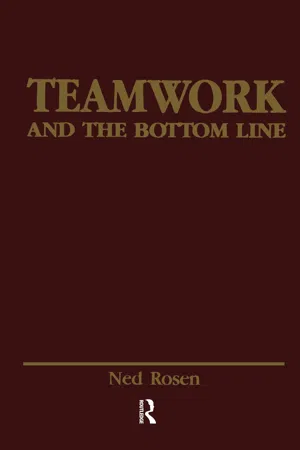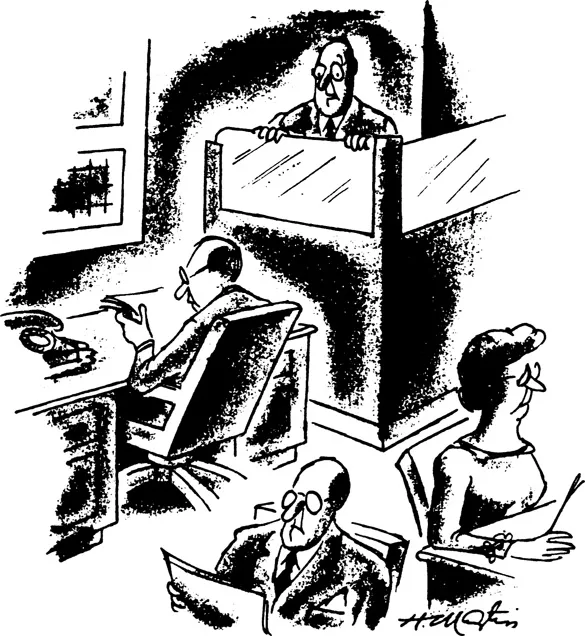![]()
CHAPTER 1
INTRODUCTION
Most of us are brought into this world with the aid of a group in the maternity ward of a hospital. We also, in most cases, will be phased out of this world with support from a group organized by a funeral home. In between we:
- are raised in a group called a family.
- go to school in something called classes.
- play games as members of teams.
- worship in groups called congregations.
- receive help, in some cases, from therapy groups.
- live in homes built by construction groups.
- even have our garbage picked up by groups.
If we travel in a large aircraft, it is operated by a flight crew. Should we be foolish enough to commit a serious crime, quite likely we will be tried by jury. If we require appendectomies or open heart surgery the operations are performed by teams, not by individual doctors working alone. And, until recent years, if invited by Uncle Sam to serve in the Army, the decision was made by a group of our neighbors called the local draft board.
Indeed, we are influenced by countless additional decision making groups. Examples include the Federal and 50 State Supreme Courts, key committees in legislatures, the National Security Council, the National Labor Relations Board, the Civil Aeronautics Board, and the Nuclear Energy Commission. For many people crucial decisions are made by a college admission committee; even if such a committee is assisted by a computer, you may be sure that the computer was both designed and built by groups.
Most of us also work in groups once we enter the labor force. In short, groups are found everywhere. Many of them are task groups. They exist to organize some level of collective effort in pursuit of a parent organization’s goals, while simultaneously satisfying needs of their individual members.
Task groups in work organizations differ from each other, as do individuals, along many dimensions:
- Their goals may be more or less clear, may be long term or short term, may or may not be socially significant, and their tasks may be more or less challenging;
- They differ in their functions - some exist purely to make decisions, others build things, some are designed to control processes or coordinate complex activities, and so on;
- Groups vary in size;
- They vary in the complexity of their internal structure and requirements for specialization among members;
- Some last longer than others (life span);
- They differ in the attitudes and prejudices shared by their members;
- Different groups employ different kinds of communications systems, and vary in their requirements for unique vocabulary;
- They differ in the extent to which they have internal harmony, in their effects on their members, in their decision making processes, and in their selection standards; and
- Finally, they differ in their methods and effectiveness at getting things done.
The above and other task group dimensions, and the context in which they operate, are what this book is about. Effective task groups, like effective people, usually don’t just happen…
TASK GROUPS AND THE SOCIAL SYSTEM AT WORK: A DISASTER CASE COMPARED WITH A SUCCESS STORY
The nation’s productivity and labor problems and achievements discussed periodically in magazines and newspapers are strongly influenced by group dynamics in work organizations. The enthusiasm displayed by space workers after a successful rocket launch reflects a common form of team spirit. Alternatively, chronic absenteeism, sub-standard productivity, negative attitudes, poor service, and shoddy workmanship are at least partly a function of inadequate attention to social organization in general and group dynamics in particular.
Disaster case - Perhaps a brief case history will illustrate my point. A major organization I once worked in had within it a packaging and shipping department staffed by approximately 120 people (almost all female) when the plant was busy. For many years the personnel worked in teams of 8 to 10 members. The teams were of fairly stable membership and became viable social units. Each team worked at a separate, mechanically paced conveyor belt. The teams’ function was to pack different products into boxes of various sizes, pack these boxes and various printed matter into larger shipping cartons and apply appropriate sealing tape and labels. The physical layout of each short conveyor and related tables and stools enabled easy, face-to-face interaction among the employees who, by-and-large, seemed to enjoy each other’s company. Indeed, some of the women were there for more than their pay; they liked being with their friends. Thus, the department evolved into a cultural unit comprised of several teams, and the social relationships seemed perfectly healthy. Relationships between workers and supervisors also were friendly.
Then came the computer. The production planning department, staffed by engineers, converted the entire plant to a computerized production scheduling system. Disregarding group dynamics, the engineers designed their computer program in a way that destroyed the long-established social structure of the department. The new system required that stable groups not be used; at the beginning of each shift and after lunch, the individuals were re-shuffled into different combinations.
In other words, group composition was changed twice every day\ As a result the attitudes and behaviors in this formerly viable department deteriorated badly. Supervisors found that they didn’t know the names of their frequently changed group members -- they began calling some of them, “Hey you.” Absenteeism increased dramatically; numerous grievances arose; the employees became agitated with peers, and excessive rest breaks were taken during working hours. To combat the latter, female supervisors were ordered by higher level managers into the ladies’ rooms to take down the names of violators. Eventually many people resigned and this became a very difficult department for which to recruit new people because its increasingly bad reputation spread throughout the community.
The above series of events illustrates that groups can be powerful and constructive forces in the work organization. The computer could have been programmed to capitalize on the existing group structure; instead it destroyed that structure and produced many of the same problems that plague work forces and organizations the world over. Please note that computerization is not the only threat to viable groups and teamwork in the work place. The extensive “re-structuring and downsizing” of many American corporations in recent years also has been highly damaging to group structure and effectiveness. I shall return to this point in Chapter Eleven.
Success story - Let me now compare the above account with a totally different experience reported in the professional research literature. A major textile manufacturer was experiencing disappointment with performance after introducing new and expensive automatic looms to replace obsolete nonautomatic machines at its mill in India. While labor-management relations reportedly were amicable, neither the quality nor quantity improvements expected of the new machines materialized. In this case, the workers were “organized” primarily as a collection of individuals, each being responsible for one of several specialized tasks in this mill, which operated more than 200 automatic looms. There were 12 specialties represented among 29 workers, covering such tasks as supplying new thread to the machines, minor repairs to work in process, correcting major machine breakdowns, removal of finished product, routine maintenance, floor cleaning and so on.
To increase productivity and quality to levels appropriate to the machines’ potential, the management had to chose between two strategies. They could keep the existing specialized staffing pattern while increasing “supervision” (meaning closer observation and prodding), or, re-organize the 29 men into teams, giving each team total responsibility for the operation and maintenance of several machines. The team strategy was chosen, and implemented with the aid of a behavioral science research group.
The action researcher reported that for more than two years after the changes were introduced, productivity improved and was maintained at ninety-five percent of potential. It was eighty percent prior to the reorganization into teams. There also was a substantial reduction in the amount of damaged cloth - a quality measure. The researcher described unusually strong worker motivation under the new system. Weavers ran, rather than walked, to their machines to repair breakdowns. Because of government labor law restrictions on work during mealtime, supervisors had to stay in the work area during lunch breaks to restrain enthusiastic team members from returning to their looms before the end of their lunch. The improved motivation and team spirit enabled the company to implement a third shift, something previously deemed impossible because of the difficult climatic conditions there. The researcher summarized as follows:
“Despite the great difference in culture between India and western societies, the same … findings in worker motivation are apparent. When people have a meaningful task and membership in a satisfactory primary work group organized meaningfully for task accomplishment they work harder and are more satisfied with their work.”1
GROUP LIFE CYCLE MAKES A DIFFERENCE
Some task groups are more effective than others, in part because they are at different phases of development. Effective leaders need to be aware of what phase of life cycle development their group is in and to use that knowledge to help the group achieve its goals.
Take the Philadelphia Flyers 1979-80 hockey team, for example. Supposedly in a “rebuilding” phase following a decline of their previous dynasty, the Flyers unexpectedly went on a record - breaking 35-game undefeated streak in late 1979 and early 1980; they became, at least temporarily, the toast of professional hockey. The Montreal Canadiens, on the other hand, winners of several consecutive hockey championships in the seasons immediately preceding 1979-80, got off to an unexpectedly slow start that year. They played lethargically and lost several early games to teams they had previously dominated. Their new coach, somehow sensing that he could not turn this decline around, resigned early in the new season. (Later in the season this team regained its form and took first place in its division.)
Direct observation and comparison of these two teams, both engaged in the same task against the same level of competition under similar economic conditions, probably would have revealed many differences. While both teams were staffed by highly talented players, the motivation levels may well have been different since one team was not expected to be a big winner while the other was. Coaching skills and style, interpersonal relations among the players, the system of maintaining internal discipline, and hometown crowd behavior also may have been much different. (Indeed, special “team building” techniques were used by the Flyer’s new coach. These techniques, which also have been used in many business organizations, are described in a later chapter.)
THE MANAGER OFTEN IS THE KEY
While many factors are important, at this point there is overwhelming evidence that one of the most important elements of task group viability is the manager. Whether a coach, first line supervisor, committee chairperson, middle level manager, or senior executive, the individual known as the group’s “manager” is a key figure. Let us move on, then, to the business at hand.
ENDNOTES
![]()
CHAPTER 2
THE MANAGER’S PART IN GROUP PROCESS
“Believe me, gang. Just because I’ve been given my own cubicle doesn’t mean I’m going to forget my old friends.”
Drawing by H. Martin; 1973 The New Yorker Magazine, Inc.
Many managers fail to realize that if they are accepted by their subordinates they also are considered by them to be part of their group. And, in circumstances where a manager does not lead a group or unit toward its goals, an inform...

